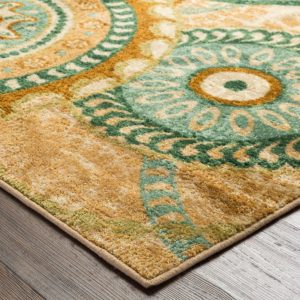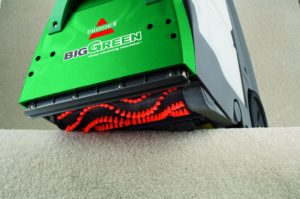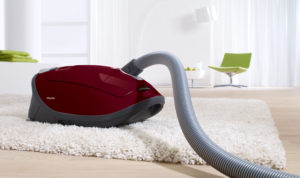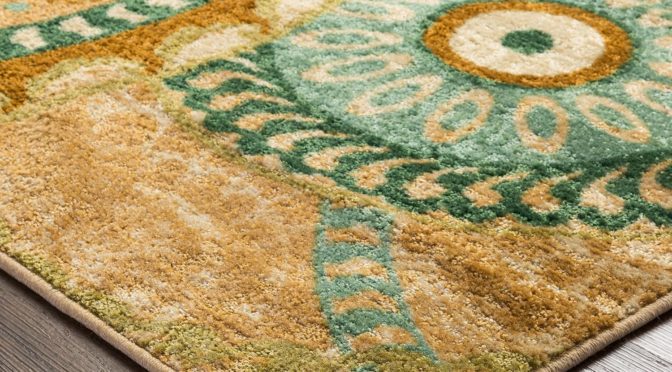
When choosing a carpet for your home, one of the first decisions you’re going to have to make involves the carpet’s style. While there are a range of natural and synthetic fiber choices as well as pile heights to choose from, you really only have around four residential carpet styles to decide between: berbers, saxonies, friezes, and cut and loop carpets. We’ve covered the first three in dozens of carpet and flooring guides, and today we’re going to look at the fourth. Besides defining cut and loop carpeting, we’ll also look at past and present styles, pros and cons, and suggested uses in the home. Naturally, we’ll also cover durability and quality concerns along the way.
What is cut and loop carpeting, and how has it changed over time?
Cut and loop carpets are carpets made through a combination of cut, or straight, carpet fibers and uncut, looped fibers. With the technique, carpet manufacturers can make a range of designs in their carpets, including geometric and abstract patterns.
Cut and loop carpets came into vogue in the 1970s and 80s but declined in popularity in the 1990s. However, as with most elements of fashion, they’ve cycled back into trendiness today, and are one of the most popular styles of carpet chosen for homes. The cut and loop carpets of the 1970s typically came in carved designs. Also known as sculptured carpets, they looked like carpets with random lines and squiggles drawn through them, which gave them a more or less marble-like texture.
The bright tones of the 70s gave way to calmer colors and sculptures in the 80s. Today, patterning trends for cut-pile carpets have shifted to geometric designs like squares, diamonds, and circles. The shapes typically are contrasted from the rest of the carpet by loops. You can also buy cut and loop carpets with pin dots and more abstract, wave- and water-like patterns.
What are the pros of cut and loop-styled carpets?
The main reason people buy cut and loop styled carpets today is because they find them attractive and eye pleasing. The patterns are visually interesting and provide some degree of texture underfoot. However, this is naturally going to vary with user preference. Our contacts in the industry, though, assure us that most people who come in looking for contemporary or modern décor will walk out of stores with cut and loop carpets and rugs over other residential styles. For better or worse, it has an association with being cutting-edge (excuse the pun).
What are the cons to cut and loop carpets?
If the main advantage of cut and loop carpeting has to do with aesthetics, it’s worth noting that the main disadvantage is also tied to looks. As cut and loop carpets age with use, they tend to look more worn out over time, even when you invest in quality carpets with long warranties. The reason for this is because the cut fibers, which are longer, tend to bloom, or untwist, and fold over the looped fibers, which are shorter, and the shorter fibers become hidden as a result.
No matter how long or short a cut fiber is, it’s going to flatten or at least bend over time. You don’t see this as much in a fully cut pile carpet like a saxony because each fiber is generally the same height and as a result, each moves together, much like a field of wheat in the wind. However, since cut and loop carpets naturally have spaces between the cut fibers to make room for the loops, it’s easier to notice leaning in the cut fibers, which, to a normal eye, won’t be interpreted as a natural feature of cut and loop carpeting, but simply wear.
Besides aesthetics, it’s also important to note that cut and loop carpets tend to cost more than other residential carpet styles of equivalent quality and fiber, such as berbers, friezes, and saxonies. The markup comes from the extra labor required to make patterns in the carpeting, which can become quite complex in higher end cut and loops.
Where does cut and loop carpeting work best in the home?
Like most carpet styles, you can get cut and loop carpets in a range of qualities and durability levels. You’ll want to figure out how much foot traffic your carpet is likely to endure, as well as how long you want the carpet to stay in good condition, before deciding whether a cut and loop carpet will work well in your home.
Typically, we advise homeowners to stay away from cut and loop carpets in areas that are going to see high traffic; this means hallways, stairs, and family or living rooms. If you use cut and loops here, they’ll often develop a worn look in a few years, and the heavier the use, the sooner the aesthetics will change. In contrast, cut and loops work well with areas that see lower or moderate levels of foot traffic; this means dens, nurseries, basements, and bedrooms. If you install them in a basement, however, make sure the basement isn’t the hub of entertainment in your home, or else it’ll count as a high traffic area again.
Do cut and loop carpets need special care for cleaning or maintenance?

While you don’t need to do anything above and beyond normal vacuuming and carpet cleaning to keep a cut and loop carpet in good condition, we still recommend choosing machines capable of cleaning them well and cleaning for years without needing repairs. When it comes to carpet cleaners, we’re fans of the Bissell 86T3 Big Green. As we’ve noted various times (e.g., here and here), it’s a machine strong enough to work in commercial applications and is probably the best value carpet cleaner you’re going to find for under $1,000.

For vacuuming, while cut and loops don’t present any particular problems compared to other residential styles, we suggest investing in buy-it-for life machines that will clean your cut and loop and whatever other styles you have in your home for as long as you own your home. In our books, that means machines like the Miele Complete C3 Soft Carpet or the Miele Compact C2 Electro+. Both can handle a range of piles and styles, and the Soft Carpet is particularly adept at cleaning carpets that other vacuums tend to destroy or get stuck on. The Electro+ is a good compromise at a slightly more family-friendly budget.
![]() You can buy the Bissell 85T3 Big Green carpet cleaner here on Amazon. You can buy the Miele Complete C3 Soft Carpet here or buy the Miele Compact C2 Electro+ here. The Mohawk Cut and Loop Forest rug above is available here.
You can buy the Bissell 85T3 Big Green carpet cleaner here on Amazon. You can buy the Miele Complete C3 Soft Carpet here or buy the Miele Compact C2 Electro+ here. The Mohawk Cut and Loop Forest rug above is available here.
![]() Canadians can buy the Miele Soft Carpet here, the Compact Electro+ here, and the Bissell Big Green here.
Canadians can buy the Miele Soft Carpet here, the Compact Electro+ here, and the Bissell Big Green here.
 If you find our research on PMC helpful, you can follow our efforts to keep maniacally reviewing home cleaning tools by shopping through our links above. We promise to keep fighting the good fight against every horror children, animals, and grown, yet messy humans can inflict upon a clean home.
If you find our research on PMC helpful, you can follow our efforts to keep maniacally reviewing home cleaning tools by shopping through our links above. We promise to keep fighting the good fight against every horror children, animals, and grown, yet messy humans can inflict upon a clean home.

